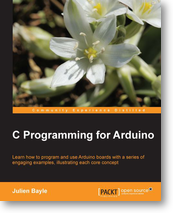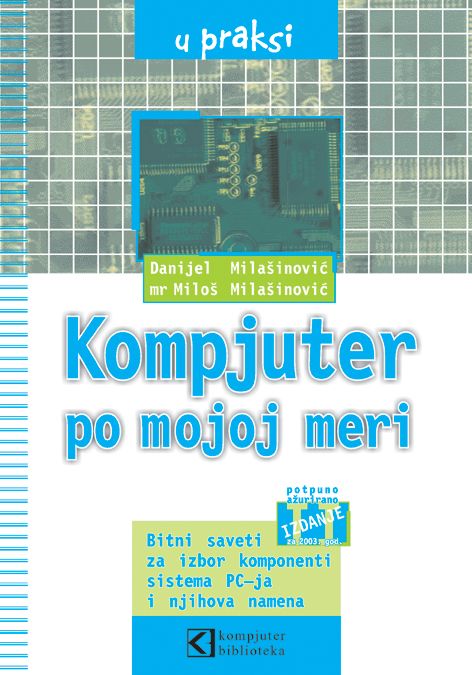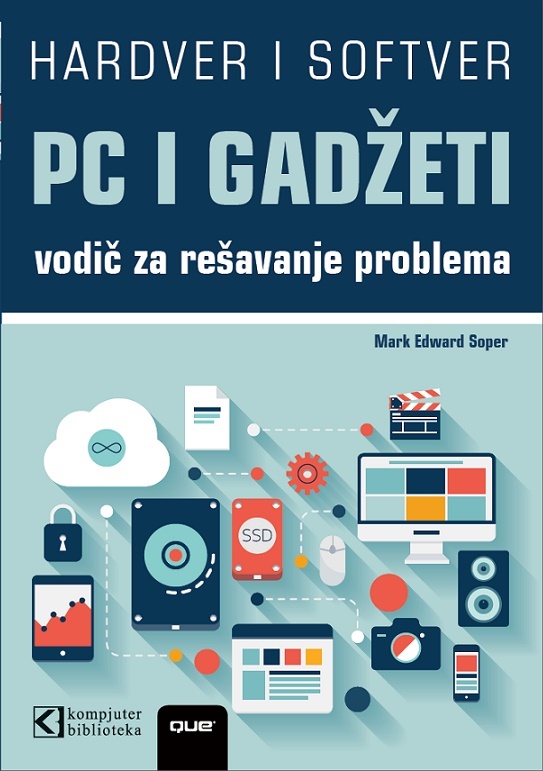
Autor: Julien Bayle
Broj strana: 512
ISBN broj: 9781849517584
Izdavač:
PACKT PUBLISHING ![]()
Godina izdanja: 2014.
 |
 |
 |
 |
 |
||||
Preface
Chapter 1: Let's Plug Things
Chapter 2: First Contact with C
Chapter 3: C Basics – Making You Stronger
Chapter 4: Improve Programming with Functions, #Math, and Timing
Chapter 5: Sensing with Digital Inputs
Chapter 6: Sensing the World – Feeling with Analog Inputs
Chapter 7: Talking over Serial
Chapter 8: Designing Visual Output Feedback
Chapter 9: Making Things Move and Creating Sounds
Chapter 10: Some Advanced Techniques
Chapter 11: Networking
Chapter 12: Playing with the Max 6 Framework
Chapter 13: Improving your C Programming and #Creating Libraries
Index
Preface
What is a microcontroller?
Presenting the big Arduino family
About hardware prototyping
Understanding Arduino software architecture
Installing the Arduino development environment (IDE)
Installing the IDE
How to launch the environment?
What does the IDE look like?
Installing Arduino drivers
Installing drivers for Arduino Uno R3
Installing drivers for Arduino Duemilanove, Nano, or Diecimilla
What is electricity?
Voltage
Current and power
What are resistors, capacitors, and so on?
Wiring things and Fritzing
What is Fritzing?
Power supply fundamentals
Hello LED!
What do we want to do exactly?
How can I do that using C code?
Let's upload the code, at last!
Summary
An introduction to programming
Different programming paradigms
Programming style
C and C++?
C is used everywhere
Arduino is programmed with C and C++
The Arduino native library and other libraries
Discovering the Arduino native library
Other libraries included and not directly provided
Some very useful included libraries
Some external libraries
Checking all basic development steps
Using the serial monitor
Baud rate
Serial communication with Arduino
Serial monitoring
Making Arduino talk to us
Adding serial communication to Blink250ms
Serial functions in more detail
Serial.begin()
Serial.print() and Serial.println()
Digging a bit…
Talking to the board from the computer
Summary
Approaching variables and types of data
What is a variable?
What is a type?
The roll over/wrap concept
Declaring and defining variables
Declaring variables
Defining variables
String
String definition is a construction
Using indexes and search inside String
charAt()
indexOf() and lastIndexOf()
startsWith() and endsWith()
Concatenation, extraction, and replacement
Concatenation
Extract and replace
Other string functions
toCharArray()
toLowerCase() and toUpperCase()
trim()
length()
Testing variables on the board
Some explanations
The scope concept
static, volatile, and const qualifiers
static
volatile
const
Operators, operator structures, and precedence
Arithmetic operators and types
Character types
Numerical types
Condensed notations and precedence
Increment and decrement operators
Type manipulations
Choosing the right type
Implicit and explicit type conversions
Implicit type conversion
Explicit type conversion
Comparing values and Boolean operators
Comparison expressions
Combining comparisons with Boolean operators
Combining negation and comparisons
Adding conditions in the code
if and else conditional structure
switch…case…break conditional structure
Ternary operator
Making smart loops for repetitive tasks
for loop structure
Playing with increment
Using imbricated for loops or two indexes
while loop structure
do…while loop structure
Breaking the loops
Infinite loops are not your friends
Summary
Introducing functions
Structure of a function
Creating function prototypes using the Arduino IDE
Header and name of functions
Body and statements of functions
Benefits of using functions
Easier coding and debugging
Better modularity helps reusability
Better readability
C standard mathematical functions and Arduino
Trigonometric C functions in the Arduino core
Some prerequisites
Trigonometry functions
Exponential functions and some others
Approaching calculation optimization
The power of the bit shift operation
What are bit operations?
Binary numeral system
AND, OR, XOR, and NOT operators
Bit shift operations
It is all about performance
The switch case labels optimization techniques
Optimizing the range of cases
Optimizing cases according to their frequency
The smaller the scope, the better the board
The Tao of returns
The direct returns concept
Use void if you don't need return
Secrets of lookup tables
Table initialization
Replacing pure calculation with array index operations
The Taylor series expansion trick
The Arduino core even provides pointers
Time measure
Does the Arduino board own a watch?
The millis() function
The micros() function
Delay concept and the program flow
What does the program do during the delay?
The polling concept – a special interrupt case
The interrupt handler concept
What is a thread?
A real-life polling library example
Summary
Up
Chapter 5: Sensing with Digital Inputs
Sensing the world
Sensors provide new capacities
Some types of sensors
Quantity is converted to data
Data has to be perceived
What does digital mean?
Digital and analog concepts
Inputs and outputs of Arduino
Introducing a new friend – Processing
Is Processing a language?
Let's install and launch it
A very familiar IDE
Alternative IDEs and versioning
Checking an example
Processing and Arduino
Pushing the button
What is a button, a switch?
Different types of switches
A basic circuit
Wires
The circuit in the real world
The pull-up and pull-down concept
The pseudocode
The code
Making Arduino and Processing talk
The communication protocol
The Processing code
The new Arduino firmware talk-ready
Playing with multiple buttons
The circuit
The Arduino code
The Processing code
Understanding the debounce concept
What? Who is bouncing?
How to debounce
Summary
Sensing analog inputs and continuous values
How many values can we distinguish?
Reading analog inputs
The real purpose of the potentiometer
Changing the blinking delay of an LED with a potentiometer
How to turn the Arduino into a low voltage voltmeter?
Introducing Max 6, the graphical programming framework
A brief history of Max/MSP
Global concepts
What is a graphical programming framework?
Max, for the playground
MSP, for sound
Jitter, for visuals
Gen, for a new approach to code generation
Summarizing everything in one table
Installing Max 6
The very first patch
Playing sounds with the patch
Controlling software using hardware
Improving the sequencer and connecting Arduino
Let's connect Arduino to Max 6
The serial object in Max 6
Tracing and debugging easily in Max 6
Understanding Arduino messages in Max 6
What is really sent on the wire?
Extracting only the payload?
ASCII conversions and symbols
Playing with sensors
Measuring distances
Reading a datasheet?
Let's wire things
Coding the firmware
Reading the distance in Max 6
Measuring flexion
Resistance calculations
Sensing almost everything
Multiplexing with a CD4051 multiplexer/demultiplexer
Multiplexing concepts
Multiple multiplexing/demultiplexing techniques
Space-division multiplexing
Frequency-division multiplexing
Time-division multiplexing
The CD4051B analog multiplexer
What is an integrated circuit?
Wiring the CD4051B IC?
Supplying the IC
Analog I/O series and the common O/I
Selecting the digital pin
Summary
Serial communication
Serial and parallel communication
Types and characteristics of serial communications
Synchronous or asynchronous
Duplex mode
Peering and bus
Data encoding
Multiple serial interfaces
The powerful Morse code telegraphy ancestor
The famous RS-232
The elegant I2C
The synchronous SPI
The omnipresent USB
Summary
Using LEDs
Different types of LEDs
Monochromatic LEDS
Polychromatic LEDs
Remembering the Hello LED example
Multiple monochromatic LEDs
Two buttons and two LEDs
Control and feedback coupling in interaction design
The coupling firmware
More LEDs?
Multiplexing LEDs
Connecting 75HC595 to Arduino and LEDs
Firmware for shift register handling
Global shift register programming pattern
Playing with chance and random seeds
Daisy chaining multiple 74HC595 shift registers
Linking multiple shift registers
Firmware handling two shift registers and 16 LEDs
Current short considerations
Using RGB LEDs
Some control concepts
Different types of RGB LEDs
Lighting an RGB LED
Red, Green, and Blue light components and colors
Multiple imbricated for() loops
Building LED arrays
A new friend named transistor
The Darlington transistors array, ULN2003
The LED matrix
Cycling and POV
The circuit
The 3 x 3 LED matrix code
Simulating analog outputs with PWM
The pulse-width modulation concept
Dimming an LED
A higher resolution PWM driver component
Quick introduction to LCD
HD44780-compatible LCD display circuit
Displaying some random messages
Summary
Making things vibrate
The piezoelectric sensor
Wiring a vibration motor
Firmware generating vibrations
Higher current driving and transistors
Controlling a servo
When do we need servos?
How to control servos with Arduino
Wiring one servo
Firmware controlling one servo using the Servo library
Multiple servos with an external power supply
Three servos and an external power supply
Driving three servos with firmware
Controlling stepper motors
Wiring a unipolar stepper to Arduino
Firmware controlling the stepper motor
Air movement and sounds
What actually is sound?
How to describe sound
Microphones and speakers
Digital and analog domains
How to digitalize sound
How to play digital bits as sounds
How Arduino helps produce sounds
Playing basic sound bits
Wiring the cheapest sound circuit
Playing random tones
Improving the sound engine with Mozzi
Setting up a circuit and Mozzi library
An example sine wave
Oscillators
Wavetables
Frequency modulation of a sine wave
Adding a pot
Upgrading the firmware for input handling
Controlling the sound using envelopes and MIDI
An overview of MIDI
MIDI and OSC libraries for Arduino
Generating envelopes
Implementing envelopes and MIDI
Wiring a MIDI connector to Arduino
Playing audio files with the PCM library
The PCM library
WAV2C – converting your own sample
Wiring the circuit
Other reader libraries
Summary
Data storage with EEPROMs
Three native pools of memory on the #Arduino boards
Writing and reading with the EEPROM core library
External EEPROM wiring
Reading and writing to the EEPROM
Using GPS modules
Wiring the Parallax GPS receiver module
Parsing GPS location data
Arduino, battery, and autonomy
Classic cases of USB power supplying
Supplying external power
Supplying with batteries
Power adapter for Arduino supply
How to calculate current consumption
Drawing on gLCDs
Wiring the device
Demoing the library
Some useful methods' families
Global GLCD methods
Drawing methods
Text methods
Using VGA with the Gameduino Shield
Summary
An overview of networks
Overview of the OSI model
Protocols and communications
Data encapsulation and decapsulation
The roles of each layer
Physical layer
Data link layer
Network layer
Transport layer
Application/Host layers
Some aspects of IP addresses and ports
The IP address
The subnet
The communication port
Wiring Arduino to wired Ethernet
Making Processing and Arduino communicate over Ethernet
Basic wiring
Coding network connectivity implementation #in Arduino
Coding a Processing Applet communicating #on Ethernet
Some words about TCP
Bluetooth communications
Wiring the Bluetooth module
Coding the firmware and the Processing applet
Playing with Wi-Fi
What is Wi-Fi?
Infrastructure mode
Ad hoc mode
Other modes
The Arduino Wi-Fi shield
Basic Wi-Fi connection without encryption
Arduino Wi-Fi connection using WEP or WPA2
Using WEP with the Wi-Fi library
Using WPA2 with the Wi-Fi library
Arduino has a (light) web server
Tweeting by pushing a switch
An overview of APIs
Twitter's API
Using the Twitter library with OAuth support
Grabbing credentials from Twitter
Coding a firmware connecting to Twitter
Summary
Communicating easily with Max 6 – the [serial] object
The [serial] object
Selecting the right serial port
The polling system
Parsing and selecting data coming #from Arduino
The readAll firmware
The ReadAll Max 6 patch
Requesting data from Arduino
Parsing the received data
Distributing received data and other tricks
Creating a sound-level meter with LEDs
The circuit
The Max 6 patch for calculating sound levels
The firmware for reading bytes
The pitch shift effect controlled by hand
The circuit with the sensor and the firmware
The patch for altering the sound and parsing Arduino messages
Summary
Programming libraries
The header file
The source file
Creating your own LED-array library
Wiring six LEDs to the board
Creating some nice light patterns
Designing a small LED-pattern library
Writing the LEDpatterns.h header
Writing the LEDpatterns.cpp source
Writing the keyword.txt file
Using the LEDpatterns library
Memory management
Mastering bit shifting
Multiplying/dividing by multiples of 2
Packing multiple data items into bytes
Turning on/off individual bits in a control and port register
Reprogramming the Arduino board
Summary
Conclusion
About Packt Publishing
About Packt Open Source
Writing for Packt
• Mladen
Nadam se da ce te je prevesti. Kupujem obavezno
• Vinko
Ovo nam treba...Kupujem obavezno

Popust cena:
440.00 rsd

Popust cena:
2280.00 rsd
© Sva prava pridržana, Kompjuter biblioteka, Beograd, Obalskih radnika 4a, Telefon: +381 11 252 0 272 |
||